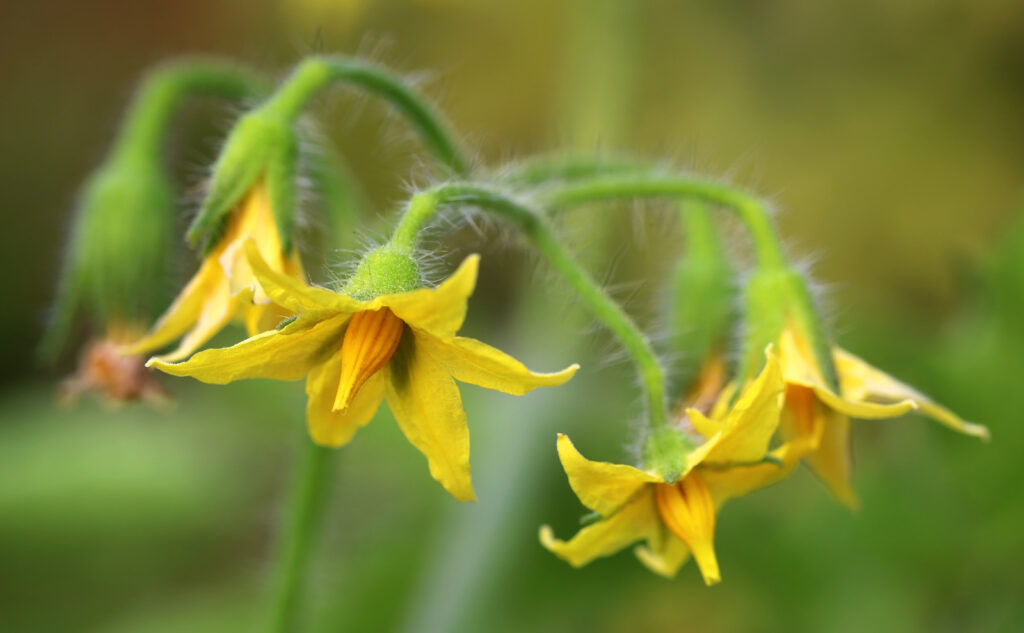Blossom drop in tomatoes can be frustrating for any gardener—one day, your plants are covered in bright yellow flowers, and the next, they’re falling off without producing fruit. I’ve grown tomatoes for years, experimenting with different varieties, soil conditions, and climate challenges, and I’ve seen firsthand how temperature swings, pollination issues, and nutrient imbalances can cause this problem. The good news? There are reliable ways to prevent blossom drop and keep your tomato plants productive. In this guide, I’ll share practical, experience-backed strategies to help you maintain healthy blooms and maximize your tomato harvest.
Tomatoes and peppers drop their blossoms when environmentally stressed. But when conditions are less extreme, a plant that has dropped its blossoms will flower again, set fruit, and be productive.
Temperatures too cold or too hot; weather too dry or too wet; soil too nutrient-rich or deficient are the most common reasons tomatoes and peppers drop their blossoms.
Best tips on How to Grow Tomatoes and How to Grow Peppers

Causes of tomato and pepper blossom drop
• Night temperatures below 60°F (16°C). Cover plants with floating row covers or plastic tunnels until temperatures warm. Wait to set out plants until night temperatures are warmer.
• Daytime temperatures above 85°F (29°C). Put shade cloth structures over plants to protect them from direct rising temperatures. Irrigate planting beds with cool water. In hot summer regions, time planting so that plants flower and set fruit before average daytime temperatures are too warm.
• A sudden shift from hot spells to cool temperatures. If cool temperatures are forecast, protect plants with floating row covers or plastic tunnels.
• Low soil moisture as a result of drought or lack of irrigation. Keep the soil evenly moist; avoid letting the soil go dry, and avoid overwatering to compensate for not watering. Work moisture-retentive aged compost into planting beds.
• Too much soil moisture as a result of rain. If summer rain is frequent, plant in well-draining raised beds or grow plants on mounds. Spread plastic around plants so that excess water runs off into furrows.
• Hot, dry wind. Plant or erect windbreaks to keep winds from reaching the crop. Plant a dense hedge upwind of the garden or erect a windbreak or fence.
• Too much nitrogen in the soil. Excess nitrogen can cause rapid, succulent growth and disrupt a plant’s metabolism. Avoid high-nitrogen soil additives such as bloodmeal and fresh manures. Use low-nitrogen fertilizers such as weak compost tea or side-dress plants with aged compost, a balanced soil amendment.
• Too little nitrogen, potassium, or phosphorus in the soil. Give plants an even fertilizer—not too much nitrogen, phosphorus, or potassium. Work aged compost into planting beds twice a year; the nutrients in aged compost are evenly balanced.
• Tarnished plant bug. The tarnished plant bug feeds on vegetable flower stems. The tarnished plant bug is ¼ -inch long, oval, flat, and brownish. Control this bug by spraying with pyrethrum or dusting with sabadilla.
• Verticillium and fusarium wilt. Fungal diseases leave plants stressed and fighting to survive; blossoms drop as the plant fights to overcome the disease. Prevention is better than cure when it comes to disease: make sure soil is well-drained; avoid overhead irrigation; space plants allowing for air circulation; eradicate weeds; remove and destroy infected plants; don’t plant members of the tomato and pepper family in the same spot two years in a row once disease hits.
Let plants set blossoms again
Tomato and peppers that suffer from environmental stress and drop their blossoms but do not succumb will commonly blossom again and set fruit once conditions improve. If plants experience early season or unexpected stress, give them optimal growing conditions as best you can and allow them to grow on. Many short-season or early-season tomatoes and tomatoes bred for hot summers are predisposed to resist early-season stress and blossom drop. Tomatoes that resist blossom drop include Big Early, Floramerica, Hot-set, New Yorker, Porter, Red Cherry, Tiny Tim, and Walter.
Growing tomato tips: How to Grow Tomatoes and How to Grow Peppers
Related articles:
Vegetable Garden Organic Weed Control
Vegetable Garden Organic Pest Control
Related Posts You Might Find Helpful:
Growing Tips
- How to Grow Tomatoes: The Ultimate Guide
- Getting Started with Tomatoes: A Gardener’s Guide to Success
- How to Choose a Tomato for Your Garden
- How to Choose the Right Tomato for Your Garden and Kitchen
- Growing Early-Season Tomatoes for Great Taste
- Heirloom and Hybrid Tomatoes
Planting Tips
- Tomato Seed Starting Tips
- Mastering Tomato Seed Starting: How to Grow Strong and Healthy Plants Indoors
- When to Plant Tomatoes: A Gardener’s Guide to Timing and Success
- Plant Tomatoes for a Thriving Crop: Sun, Soil, and Spacing
- How to Transplant Tomato Seedlings: A Gardener’s Guide
- Growing Tomatoes in Containers
Tomato Care
- Watering and Feeding Tomatoes: Expert Tips for a Healthy, Productive Crop
- Best Ways to Support Your Tomato Plants
- Pinching and Pruning Tomatoes: A Gardener’s Guide to Healthier, More Productive Plants
- How to Prune Tomatoes
- Grow Tomatoes on Stakes
- Best Companion Plants for Thriving Tomatoes: What Works & What to Avoid
Pest & Disease Control
- Tomato Growing Problems: Pests, Diseases, and Solutions
- How to Prevent Blossom Drop — Tomatoes and Peppers
- How to Identify Early Blight, Late Blight, and Leaf Spot on Tomatoes
Harvest & Preparation
- When and How to Harvest Tomatoes for the Best Flavor
- How to Ripen Tomatoes
- Planting Tomatoes for a Long Harvest
- Planting Tomatoes for a Fall Harvest: How to Grow Fresh Tomatoes Before Frost
- Tomato Flavor Explained
- Nine Ways to Cook and Serve Tomatoes
Books to help you grow:
- Vegetable Garden Almanac & Planner
- Kitchen Garden Grower’s Guide Vegetable Encyclopedia
- Vegetable Garden Grower’s Guide
- Tomato Grower’s Answer Book



